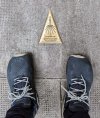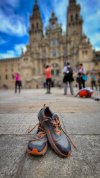From a previous post I made:
----------
Here's a bit of additional information on making homemade rock plates/shields from a past post I wrote. It really is a pretty easy fix to a shoe that is otherwise a great fit.
----------------------------------------------------------------------
If the imprint of trail debris, poking at your feet through the outersole of your shoe, is making your feet sore, you may want more shielding. A simple and effective DIY solution is to make a Rock Plate at home. The Rock Plate will slip under your insole, and provide a very effective level of protection without a huge penalty to the 'feel' of the shoe..
Take a thin and flexible plastic, like that found in milk jugs, or a
thin plastic cutting board or
plastic sheet
Using your insole as a template, mark an outline of the insole onto the plastic. Cut out the outline. Place the cut out into the shoe, under your insole. If needed, use some double surface tape, like carpet tape, to affix your new 'rock plates' to the bottom of the shoes.
If you still find that you need more shielding, add a second pair and see how that works for you.
Increasing the cushioning to the foot is another method of shielding feet from trail debris. Some shoes, like many models of the Hoka One One, build this into some of their shoe models. Aftermarket insole inserts are another way to add such cushioning, which some folks find effective.
Insoles with effective open cell foams and elastic polymers can provide extra cushioning that will also provide some additional support to your foot structures. As the foot slightly sinks into the cushion, it creates an impression that will slightly fill in the void under your arches.
This is an example of this type of insert; there are others that can also be effective.
I always take an extra insole with me, not an extra pair of footwear. I find that if my footwear feels good walking, it will be sufficiently comfortable for lounging around after a long day of backpacking or walking Camino. Of course, wearing lightweight trail runners rather than heavier footwear make this option easy.
I designate one insole as my walking insole. That's the one I will. . well. . do all my backpacking and Camino walking with. The
extra insole that I take with me, is usually the one that came with the shoe.
The factory insoles are usually very light. When I swap out insoles at the end of the day, and will be walking around the village or town seeing the sights, getting dinner, shopping, etc, the factory insoles are more than sufficient for that walking task. Swapping out insoles allows my walking insoles to air out.
Like shoes, aftermarket insoles are an individual fit-and-feel type of thing. No one can reliably tell someone else that the aftermarket insole
they like, will be a good match for another. If shopping for an insert, it can take quite a bit of trial and error to match your feet to a specific insole. There is a reason why so many aftermarket products exist; one type does NOT fit all.

The most valuable thing about such recommendations, are the observations about wear and tear, and quality control. Do they break down quickly? Cost? That sort of thing.



























